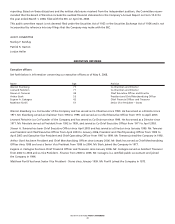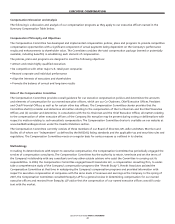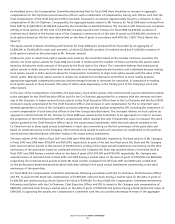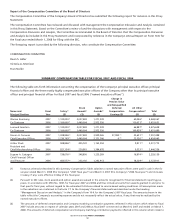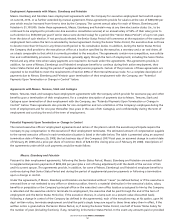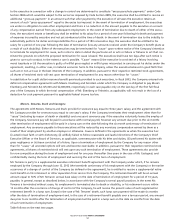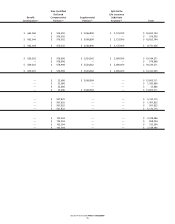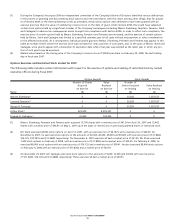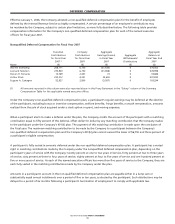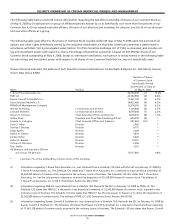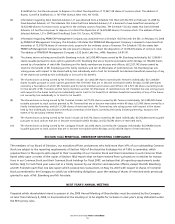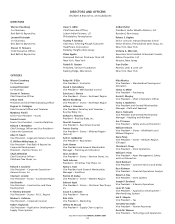Bed, Bath and Beyond 2007 Annual Report Download - page 55
Download and view the complete annual report
Please find page 55 of the 2007 Bed, Bath and Beyond annual report below. You can navigate through the pages in the report by either clicking on the pages listed below, or by using the keyword search tool below to find specific information within the annual report.BED BATH& BEYOND PROXY STATEMENT
53
to the executive in connection with a change in control are determined to constitute “excess parachute payments” under Code
Section 280G which would be subject to the excise tax imposed by Code Section 4999, the executive shall be entitled to receive an
additional “gross-up payment” in an amount such that after payment by the executive of all taxes the executive retains an
amount of such “gross-up payment” equal to the excise tax imposed. In the event of termination of employment, the executives
are under no obligation to seek other employment and there is no reduction in the amount payable to the executive on account
of any compensation earned from any subsequent employment. In the event of termination due to death of either of the execu-
tives, the executive’s estate or beneficiary shall be entitled to his salary for a period of one year following his death and payment
of expenses incurred by executive and not yet reimbursed at the time of death. In the event of termination due to the inability to
substantially perform his duties and responsibilities for a period of 180 consecutive days, the executive shall be entitled to his
salary for a period of one year following the date of termination (less any amounts received under the Company’s benefit plans as
a result of such disability). Either of the executives may be terminated for “cause” upon written notice of the Company’s intention
to terminate his employment for cause, such notice to state in detail the particular act or acts or failure or failures to act that con-
stitute the grounds on which the proposed termination for cause is based. The executives shall have ten days after such notice is
given to cure such conduct, to the extent a cure is possible. “Cause” means (i) the executive is convicted of a felony involving
moral turpitude or (ii) the executive is guilty of willful gross neglect or willful gross misconduct in carrying out his duties under the
agreement, resulting, in either case, in material economic harm to the Company, unless the executive believed in good faith that
such act or non-act was in the best interests of the Company. In addition, pursuant to their respective restricted stock agreements,
all shares of restricted stock will vest upon termination of employment for any reason other than for “cause.”
In substitution for a split dollar insurance benefit previously provided to such executives, in fiscal 2003, the Company entered into
deferred compensation agreements with Messrs. Eisenberg and Feinstein under which the Company is obligated to pay Messrs.
Eisenberg and Feinstein $2,125,000 and $2,080,000, respectively, in each case payable only on the last day of the first full fiscal
year of the Company in which the total compensation of Mr. Eisenberg or Feinstein, as applicable, will not result in the loss of a
deduction for such payment pursuant to applicable federal income tax law.
Messrs. Temares, Stark and Castagna
The agreements with Messrs. Temares and Stark provide for severance pay equal to three years’ salary, and the agreement with
Mr. Castagna provides for severance pay equal to one year’s salary, if the Company terminates their employment other than for
“cause” (including by reason of death or disability) and one year’s severance pay if the executive voluntarily leaves the employ of
the Company. Severance pay will be paid in accordance with normal payroll, however any amount due prior to the six months
after termination of employment will be paid in a lump sum on the date following the six month anniversary of termination of
employment. Any severance payable to these executives will be reduced by any monetary compensation earned by them as a
result of their employment by another employer or otherwise. Cause is defined in the agreements as when the executive has:
(i) acted in bad faith or with dishonesty; (ii) willfully failed to follow reasonable and lawful directions of the Company’s Chief
Executive Officer or the Board of Directors, as applicable, commensurate with his titles and duties; (iii) performed his duties with
gross negligence or (iv) been convicted of a felony. Upon a termination of employment by the Company for any reason other
than for “cause,” all unvested options will vest and become exercisable. In addition, pursuant to their respective restricted stock
agreements, all shares of restricted stock will vest upon any such termination of employment. These agreements also provide
for non-competition during the term of employment and for one year thereafter (two years in the case of Mr. Castagna), and
confidentiality during the term of employment and surviving the end of the term of employment.
Mr. Temares is party to a supplemental executive retirement benefit agreement with the Company under which, if he remains
employed by the Company through June 12, 2012 (the twentieth anniversary of his employment with the Company) or the earlier
occurrence of a change of control of the Company (as defined in the agreement), he is entitled to receive a supplemental retire-
ment benefit on his retirement or other separation from service from the Company. The retirement benefit will be an annual
amount equal to 50% of Mr. Temares’ annual base salary on the date of termination of employment for a period of 10 years,
payable, in general, except as described below, in accordance with the Company’s normal payroll practices. In the event Mr.
Temares is terminated without cause, his employment is terminated due to death or disability, or his retirement occurs within
12 months after the occurrence of change of control of the Company, he will receive the present value of such supplemental
retirement benefit in a lump sum. Except in the case of Mr. Temares’ death, such lump sum payment will be made six months
after the date of termination of employment and, in the case of a retirement benefit payable over a ten-year period, any amount
due prior to six months after the termination of employment will be paid in a lump sum on the date six months from the date
of such termination of employment.
Table follows on the next two pages.


